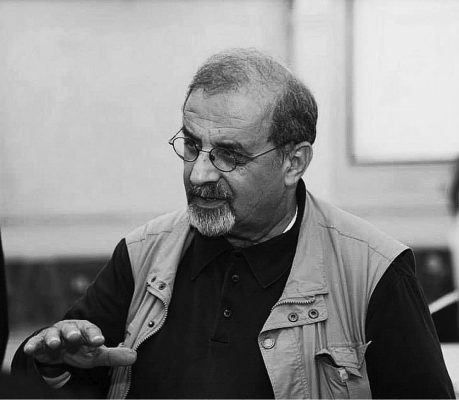BADRAN, RASEM (1945-)
Born in Jerusalem in 1945; son of Jamal Badran; worked with his father in his Jerusalem studio and later in Ramallah; was educated in Ramallah; won his first award for painting at the age of 12 in India; received an MA in Architecture from the Technical University of Darmstadt, Germany, in the early 1970s; worked in Germany for a while; participated with some colleagues in the exhibition ‘Elementa 1972,’ which enabled them to realize their designs on experimental accommodation units in an area of the city of Bonn; returned to Ramallah later that year; moved to Amman in 1973 and opened his own architectural office ‘Dar Al-Umran’; worked as artist, calligrapher and architect since; had architecture exhibitions in Berlin and Stuttgart in 2005; is considered one of the most influential architects in the Arab world; his works include the villas Hand-hal (1975) and Hatahat (1979) in Amman, the Abu Ghueillah housing complex and the King Abdullah Mosque in Amman (1979), the Baghdad State Mosque (1980), the Palace of Justice in Riyadh (1984), a Mosque in Doha (1985), the Beit Al-Kamel Apartment and Office Building in Sana’a (1987), the Madi Commercial Center in Amman (1987), the Great Mosque and the redevelopment of the old city center Qasr Al-Hokm in Riyadh, the National Archeological Museum of Amman in 1991, the Saudi National Museum in Riyadh in 1994 and the Qatar Islamic Arts Museum in Doha in 1997; currently works on the Damascus University Central Library and the Jabal Omar Housing Compound in Mecca; is permanent member of the Academic Council for the International Academy of Architecture in Sofia since 1990; received many awards and prizes, incl. the Arab Architecture Award in Marokko in 1990; the Aga Khan Architecture Award in 1995, the Palestinian Architecture Prize in 1997 and the first Prize of the Arab Architects awarded by the Arab League in 1997; Professor of Architecture; James Steele published a book about his style and work, entitled The Architecture of Rasem Badran - Narratives of Peoples and Places (Thames & Hudson, 2005).

بدران، راسم (1945 - ) من مواليد مدينة القدس عام 1945؛ نجل جمال بدران؛ تلقى تعليمه في مدينة رام الله؛ عمل مع أبيه في الأستوديو الخاص به في القدس ثم في رام الله؛ حاز على أول جائزة للرسم عندما كان يبلغ اثنا عشر عاماً (في الهند)؛ حاز على شهادة الماجستير في فن العمارة من جامعة درامستادت Technical University of Darmstadt في ألمانيا في أوائل السبعينات؛ عمل في ألمانيا في بداية السبعينات؛ شارك في معرض 1972 ‘ Elementa ’ في مدينة بون الألمانية؛ عاد إلى رام الله في وقت لاحق عام 1972؛ انتقل إلى عمان عام 1973 وافتتح مكتباً معمارياً خاصاً به عرف ب “دار العمران”؛ عمل كفنان وخطاط ومهندس معماري؛ أقام عدة معارض معمارية في برلين وشتوتغارت في ألمانيا عام 2005؛ يعتبر أحد أهم المهندسين المعماريين من أصحاب النفوذ في العالم العربي؛ تتضمن أعماله عدداً من البيوت المميزة في عمان، مجمع أبو غويلة للإسكان، مسجد الملك عبد الله في عمان (1979)، مسجد بغداد (1980)، قصر العدل في الرياض (1984)، مسجد الدوحة (1985)، شقة بيت الكامل ومبنى دار العدل في صنعاء (1987)، هذا إضافة إلى مركز تجاري في عمان (1987)، الجامع الكبير وقصر الحكم في مركز البلدة القديمة في الرياض، المتحف الوطني في الأردن (1991)، المتحف الوطني السعودي في الرياض (1994)، ومتحف قطر للفنون الإسلامية في الدوحة (1997)؛ عمل على مشروع المكتبة المركزية في جامعة دمشق ومشروع جبل عمر للإسكان في مكة؛ عضو دائم في المجلس الأكاديمي التابع للأكاديمية الدولية للفن المعماري في صوفيا منذ عام 1990؛ حاز على عدة جوائز، بما فيها جائزة فن العمارة العربية في المغرب عام 1990، جائزة الآغا خان للعمارة الإسلامية عام 1995، جائرة الفن المعماري الفلسطيني عام 1997، والجائزة الأولى للمهندسين المعماريين العرب التابعة لجامعة الدول العربية عام 1997؛ أستاذ فن العمارة؛ نشر جيمس ستيل كتاباً عن فنه (بالإنكليزية) بعنوان: فن عمارة راسم بدران - حكايات الناس والقصور (2005).
